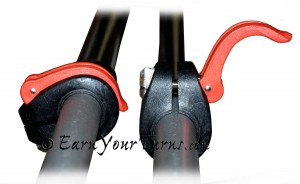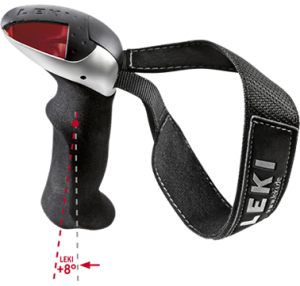Three years ago Leki realized backcountry skiers had given up on their twist-lock adjustable ski poles, including their improved SuperLock adjustment system. So they created their SpeedLock adjustment mechanism. The SpeedLock is the only external adjustment system that is TUV certified with a clamping pressure in excess of 55 kg. They now offer several models of SpeedLock poles, from the economical Tour Vario model to the ultra light, carbon fiber Tour Carbon with three sections that collapses down to less than 28 inches (70 cm) in length.
Last season I enjoyed checking out Leki’s Haute Route pole which has all the basic features you could want in an adjustable ski pole, including the SpeedLock adjustment, a carbide tip, Aergon™ grip and durable, lightweight 7075 aluminum shafts.
Yes, the SpeedLock does borrow from the FlickLock™ concept of squeezing the outer shaft around an inner shaft, but it requires less force on the adjustment lever, yet delivers more contact pressure between the interleaved shafts. Leki creates this paradoxical balance of an easier to clamp lever with higher shaft clamping forces, not through a cammed lever, but by using a plastic clamp that is more flexible than the classic slotted metal sleeve. Other compression lock systems, such as BD’s FlickLock system clamp by squeezing the metal outer shaft down on the inner shaft. Leki’s SpeedLock doesn’t bend the metal, but exists independent as a plastic sleeve below the upper shaft. Thus, the clamping force can be applied over a greater surface area. This yields the strongest clamping force of compression style lock mechanism. Leki’s founder was adamant that the locking pressure of the twist lock they had developed be exceeded. Otherwise, why bother? The result is it applies the force over a larger surface area. Thus, less lever force is required to clamp it, yet it has greater holding pressure to prevent collapsing. Which is a long winded way to say that they made it easier to operate, with more reliability.
Say goodbye to collapsing adjustable poles from Leki, and welcome back to Leki quality in the backcountry world. After a full season of use the Haute Route SpeedLock pole I’ve been using never collapsed, either randomly or when subjected to lots of compressive force, like when switching modes on BD’s O1 binding, or jamming the pole into hard snow.
Aside from the SpeedLock there are several other features worth considering, most notable being the option of a pole outfitted with their edgeless Aergon™ grip. At first look it doesn’t appear to be anything other than an egg-shaped grip. However, if you’ve ever used a ski pole with a poorly designed grip you know how uncomfortable the smallest imperfection can become after several thousand pole plants, whether up or downhill. In a word, the Aergon grip is the epitome of comfort, whether palming it on top, with all your fingers around the length of the grip, or chocking up..The straps around the grip are easy to adjust, and for most models, permanently attached. They can be replaced by tapping out a retaining pin from the side. My fave feature is the long version of the Aergon grip where the upper shaft is covered in soft foam rubber to give solid grip when you’re choking up on the upper pole in the skin track.
Is there anything to not like about these poles? Although the Aergon grip is super comfortable on your hands, the lack of a sharp edge can make using the grip to hook on to things like climbing bars at your heel, or the touring lever of an NTN binding difficult. If your palms are sensitive to those sharp edges when skinning, this would be an acceptable compromise. Or get the Tour Vario with a more traditional grip.
For those who still equate Leki with twist-lock, and twist-lock with collapsing pole syndrome, Leki’s SpeedLock series renders that perspective to the dust bin of history.
How ’bout you? Any experience with the new SpeedLock series from Leki?
Leki
Tour Vario SpeedLock
MSRP: $100
Weight/pr.: 21 oz. (596 g)
Haute Route
MSRP: $140
Weight/pr.: 20.75 oz. (588 g)
Tour Carbon
MSRP: $240
Weight: 19.9 oz. (564 g)
© 2012





2 comments
2 pings
I have the model that REI was selling last year. I think Leki called it the “tour ultralight”. They have a lot more models that you listed, which is really confusing, as there is no information provided on their web site as to what the difference are.
Anyway, I love them but they are ‘ultralight’ because the lower shaft is very thin aluminum. One broke while I was just jamming it into soft snow. Realized later that I had it about 1 mm past the ‘maximum extension’ line, so sort of my fault. That’s not much tolerance though!
REI replaced them; I was then using them at the resort and bent the lower shaft on one. A bit annoying, but okay; it still functions.
I would buy these again but would opt for a beefier model (if I could figure out which the beefier model actually is).
The speed lock works as advertised — very very well.
Personally the real selling point of the Leki poles is the trigger grip. Without this they are just another adjustable pole.
For Eric, the carbon lowers are very durable, I have been using the same pair for years with no issues.
[…] adjustable poles, even BD’s FlickLock® concept could be improved upon (see K2 & Leki), so they did. FlickLock® Pro opened […]
[…] like BD’s Flick-Lock or the many variations like K2′s Lock-Jaw or Leki’s Speed Lock? No, it can’t be claimed as superior, but perhaps equal in terms of locking strength and ease […]